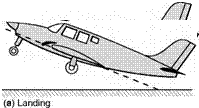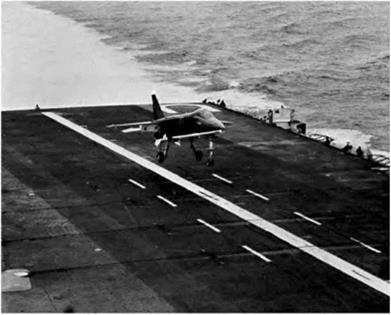Landing
The art of landing an aeroplane consists of bringing it in contact with the ground at the lowest possible vertical velocity and, at the same time, somewhere near the lowest possible horizontal velocity relative to the ground. It is true that in certain circumstances a fast landing may be permissible, and that some modern aircraft are flown onto the ground in a definitely unstalled con-
(a)
![]()
![]()

![]()
 (g)
(g)
Fig 6.5 Air brakes dition, but the general rule applies to the landings of many slower and lighter types, and especially to forced landings in which everything usually depends on the minimum horizontal velocity being achieved.
The reader will have noticed that it is the horizontal velocity relative to the ground which must be reasonably low. Now, the first step in this direction is to land against the wind and so reduce the ground speed. This, however, is entirely up to the pilot; in our present problem we are only concerned with a low air speed. Given this low air speed, the pilot can, by landing into the wind obtain a low ground speed. In the case of landing on the decks of ships (Fig. 6B, overleaf), if the ship herself steams into the wind, the ground speed will be still further reduced. Supposing, for instance, the minimum air speed of an aeroplane is 80 knots, the wind speed is 20 knots, and the ship is steaming at 30 knots into the wind, then the ‘ground’ speed of the aeroplane when landing will be only 30 knots; while if the wind speed had been 50 knots, the ‘ground’ speed would have been reduced to nil – a perfectly possible state of affairs.
In an early chapter it was mentioned that the wind speed is apt to be irregular near the ground, and it is when landing that such irregularity may be important. If the wind speed suddenly decreases, the aircraft, owing to its inertia, will tend to continue at the same ground speed and will therefore lose air speed, and, if already flying near the critical speed, may stall. Similarly, if the wind speed suddenly increases, the aircraft will temporarily gain air speed and will ‘balloon’ upwards, making it difficult to make contact with the ground at the right moment. Such instances may occur in changeable and gusty winds, in up-currents caused by heating of parts of the earth’s surface, in cases of turbulence caused by the wind flowing over obstructions such as hills and hangars, and due to wind gradient. Of these, wind gradient is probably the most important, and the most easily allowed for. An aeroplane, when landing against a high wind, will encounter a decreasing wind speed as it descends through the last few feet and will be in danger of stalling unless it has speed in hand to compensate for the air speed lost. If landing up a slope or towards a hangar, one may suddenly run into air which is blanketed by the
|
|
Fig 6B Deck landing
(By courtesy of the former British Aircraft Corporation, Preston) The Jaguar, designed by Breguet and ВАС, landing on a deck.
obstruction, or a head wind may even become a following wind blowing up the hill or towards the hangar. In a really high wind, and when flying a small light aircraft, these conditions may be dangerous, and the obvious moral is to allow for them by approaching to land at a higher speed than usual.
The vertical velocity of landing can be reduced to practically nothing provided the forward velocity is sufficient to keep the aeroplane in horizontal flight – that is to say, provided the lift of the wings is sufficient to balance the weight of the aeroplane.
We have already seen that there is a definite relationship between the indicated air speed and the angle of attack. Fig. 6.6 illustrates the attitudes of an aeroplane at various speeds and the corresponding angles of attack required to maintain level flight: (a) shows the attitude of maximum speed; (b) that of normal cruising flight; (c) that for an ordinary landing; and (d) the attitude when fitted with flaps and slots and flying as slowly as possible.
Now, since lift must equal weight, and must also equal CL. ypV2 . S, it is quite obvious that if У is to be as small as possible, CL must be as large as possible. The pilot may never have heard of a lift coefficient, and he may be none the worse a pilot for that; but, consciously or unconsciously, he will increase CL by increasing the angle of attack until he decides (it matters not whether his decision is based on scientific knowledge, instinct or bitter experience!) that
 |
 |
Fig 6.6 Attitudes for level flight
any further increase in the angle of attack will decrease rather than increase the lift; in other words, until he has come near to that stalling angle which we considered so fully when dealing with aerofoils. At this angle (about 15° to 20° in the case of an ordinary aerofoil), CL is at its maximum, and therefore V is a minimum.
If the pilot, through lack of any of the three qualities mentioned above, exceeds this angle, then both CL and V will decrease; therefore CL. ypV2 . S can no longer equal the weight and the aeroplane will commence to drop. For 20 m, 50 m, or more, the vertical component of velocity will increase and the nose of the aeroplane will drop, therefore the pilot must beware that, when he does this experiment of flying as slowly as possible, he is either very near the
ground or at a considerable height above it. In fact, slow landings should not be practised between 1 and 500 m from the earth’s surface, and the whole skill of the pilot is exercised in approaching the ground in such a manner that he has reached the correct condition of affairs just as he skims the surface of the runway, provided, of course, that he has sufficient clear run in front in which to pull up after landing.












